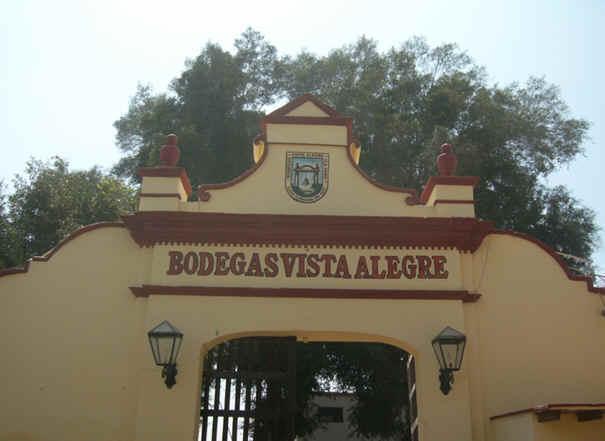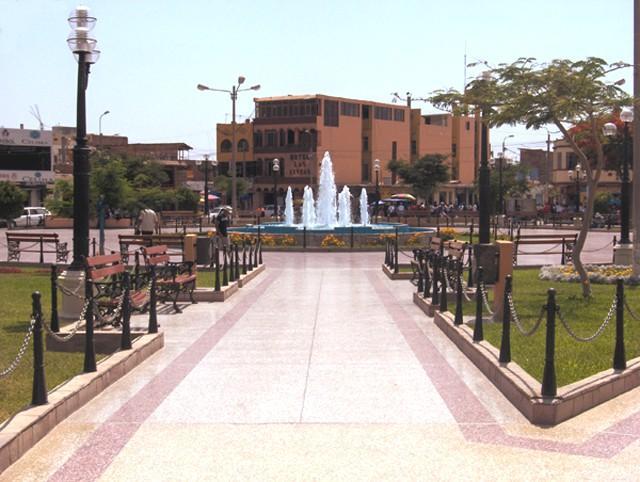Nazca, Ica, Peru
Suggest Place to Visit
3020
Track to location with GPS |
 |
There are two versions of its Spanish foundation. According to writings of chroniclers, it was founded on October 28, 1548, commissioned by the peacemaker Pedro de la Gasca, by Don Alonso de Mendoza. The other version says that it was founded by Viceroy García Hurtado de Mendoza, Marquis of Cañete, in 1591.
Nasca was also known for producing a grape brandy - similar to pisco - destined for the consumption of slaves, and which the local inhabitants called Nasca. It is also said that the first grape brandy (pisco) was produced at Hacienda Cahuachi, by an African-American slave of the owners of this estate.
In Regional History of Ica: Colonial Era, tI (1964), by Alberto Rossel Castro, chapter VII, entitled Colonial History of the Nasca Valley, refers that since before the conquest, the Nasca Valley was known by the name of Caxamarca, as recorded in the titles of deeds, of the corregidores and Royal Cédulas of the time, which begin with this tenor: ... in the town of Caxamarca de la Nasca.
He points out that the Caxamarca District comprised three large Partialities: Nasca, Kollao and Palpa. That the Naska Partiality extended through the Aja and Kopara ravines, in today's words, Tierras Blancas and Las Trancas.
That the Partiality of the Collao corresponded to the Ingenio Valley, and the Partiality of Palpa was located between the streams of the Rio Grande and that of the Viscas.
It indicates that thirteen ayllus made up the Nasca Partiality, of which only the Ayllus Amoto, Copara, Poruma, (poroma) Cantallo, Siamesas and Pallas are counted, which belonged to the commission of Captain Pedro Gutiérrez de Mendoza.
The Collana ayllu was the main one and its components boasted of belonging to the royal blood of the Incas of Cusco. The Nasca dynasty belonged to this ayllu, whose family settled, upon the arrival of the Spaniards, in the Inca town of Caxamarca, whose ruins are located at the exit of the current city and which is known by the name of Los Paredones .
Rossel Castro says that the chief curacas or chiefs of the Repartimiento of Caxamarca, in the year 1546, were Don Francisco Nanaska and Don Alonso Rimansa, the latter's son from Anqueada, owners of the lands of Collao and Caxamarca. This was stated by both before the first Ordinary Mayor, Don Nicolás de Rivera el Viejo on June 17, 1546 in a document that appears in the Property Law file, Leg. 3, notebook 83, year 1546, in the National Archive.
The first curaca or chief, Don Francisco Nanaska, is succeeded in the chiefdom of Caxamarca by his legitimate son, Mr. García Nanaska, (godson of the encomendero Garcia Salcedo, later married to Beatriz Illacuchi, daughter of the chief or chief of Lurin Ica Aquije) who in His will dated November 4, 1569, located by Fr. Rossel Castro in the National Archive, states that he has a legitimate son named García Nanaska, two years old, for which he delegates the power to govern the chiefdom in his brother Don Pedro Vilcanchana.
On March 13, 1582, before the Notary Public García de Córdova, the name of García Nanaska already appears, at the age of 19, together with the other representatives of the Repartimiento, such as Mr. Luis Vininanchana, Mr. Fernando Capcha, Mr. Baltasar Camote and Don Francisco Michilla, which proved, says Rossel, that Don García Nanaska had already taken over the curacazgo or cacicazgo.
On the founding of the colonial town of Santiago de la Nasca, he relates that Don García Nanaska Sr., and Don García Nanaska Jr., were the true benefactors of the Caxamarca Valley, who donated their goods to the encomenderos for the formation of the colonial people on the site of the Partiality of Naska, giving it the name of Santiago Apóstol de Nasca, where the other indigenous people of the valley were reduced and the seats were given to the Spaniards in the year 1549, dated perhaps July 25, the day of the saint's feast patron of the town.
On the foundation of the Convent of San Agustín (place between the first block of Arica street, the fifth block of the right street or Lima, and the neighborhood of the cans, first block of Grau and the Tierras Blancas river bank) It states that just as Don García Nanaska had instituted a Chaplaincy at the altar of San Pablo with part of his assets, Don García Nanaska Jr., following the example of his father, taxed his estates in favor of the Augustinian Fathers of Lima, to condition that they say two hundred Masses in favor of his soul and his body be buried inside the Church of Santiago Apóstol de Nasca. Thus, on May 16, the Augustinians requested the execution of the chieftain's will and the license to build the church of the Augustinian Convent in the Nasca Valley, the construction of which was carried out in 1591.
The author continues by narrating that the colonial population of Nasca was elevated to Villa and its specified terms in Acarí, Anan-Huayurí, Urin, Huayurí, Palpa and Ingenio, in times of the Viceroy Don Luis de Velasco y Castilla, Count of Nieva, and in the same time of the founding of the Villa de Valverde de Ica that took place on July 17, 1563.
He says that it was the chief García Nanaska Sr., who gave a seat to the Spanish neighbors and residents, to the Christian soldiers serving the Viceroy, for a house and an orchard, according to the rules issued from Spain by the King. This seat was made in the same place where the current city of Nasca is located.
The town of Nasca was created on August 29, 1821, then on July 2, 1855 it was elevated to the category of district, becoming a province on January 23, 1941.
Nasca, is how it is called today, it is a dry place, which is why in the Inca times a formidable work of hydraulic engineering was carried out, moving water from the heights, in underground branches, called aqueducts, which serve to this day , for irrigation of farmland and for domestic use.
In colonial history, there were model farms such as San Juan del Ingenio and San Javier owned by the Jesuit College of Cusco, in which wood carving, vine cultivation, wine processing for Catholic worship were carried out, and two beautiful churches located in these places. In 1767 to the expulsion by edict of King Carlos III of Spain, these properties were at the disposal of the Crown, and owned by an encomendero.
In times of the Republic, they were given in use by the Peruvian Congress, in 1828, to the French-Argentine corsair Hipólito Bouchard, as a reward and in gratitude for the services rendered to the Peruvian state. Bouchard founded a sugar mill that he called La Buena Suerte, a place where he was assassinated by a mob of slaves led by the Afroanasqueño Adelfo Bernales, who later allegedly raped his wife on January 4, 1837. After 120 years, in June 1962, a grave with the initials HB was found on the cat
Nazca is a Peruvian city located in the south-central region of Peru, capital of the Nasca Province, located on the right bank of the Aja River, a tributary of the Rio Grande. Located 450 km south of the city of Lima, in a narrow valley at 520 meters above sea level.
Nasca is a very active city, due to the influx of tourists who visit the thousand-year-old Nasca Lines daily, and also due to the booming mining, agricultural and commercial development of the area, which is making it one of the most cosmopolitan cities in the world. South Peruvian.
Tourist attractions
The famous Nazca Lines represent in the province the greatest tourist attraction and source of income for the Nazca population.Nazca Lines: located in the San José pampa and over an area of 50 km, the geoglyphs represent figures of animals and plants Some of these figures can measure up to 300 meters in length and occupy a surface area of 1000 m².
Cahuachi: citadel and ceremonial center of the ancient Nascas, there are two stepped adobe pyramids, very close is the place known as Estaqueria, where carob stakes are kept.
Chauchilla Cemetery: located 10 km south of the city of Nazca contains pottery and pre-Inca mummies.
Aqueducts of Cantalloc: located 4 km north of the city of Nazca built by the Nazca culture and they work today, demonstrating their technological advances in hydraulic engineering, they built more than 40 aqueducts, which were used all year round, to be able to develop efficient agriculture capable of satisfying the needs of the population of that time, there are other aqueducts in various parts of the city
Cerro Blanco: located east of the city of Nazca, the largest dune in Peru; ideal for the practice of adventure sports such as sandboarding and paragliding.
Nazca Municipal Museum: you can see ceramics and textiles from the Nazca culture.
Comments
We don´t have yet any comments about:
Nazca city
Nazca city
Be the first to leave a comment as it is very important to inform other people
Outros locais a visitar
Within a radius of 20 km from:Nazca city
Bodega Vista Alegre |
| 1,1 Km |
 |
Acueducto de Cantalloc |
| 1,7 Km |
 |
Maria Reich House Museum |
| 4,6 Km |
 |
Lines of Nazca (Nazca) |
| 5,9 Km |
 |
Cahuachi Ceremonial Center |
| 8,4 Km |
 |
Hotel reservation near Nazca city within a radius of 20 km
Why to book with CLUBE TRAVEL
The best prices
Our partnerships with the world´s largest operators offer research on the best market prices.
More options
At Rotas Turisticos you can book the hotel, buy the air ticket, book the transfer from the airport to the hotel and vice versa, book the local excursions, rent the car, take travel insurance and consult the places to visit and where to go.
Holiday Tips & Destinations
Hundreds of holiday destinations with all the options that allow you to easily choose the destination that best suits your dream vacation.
CLUBE TRAVEL
Links






